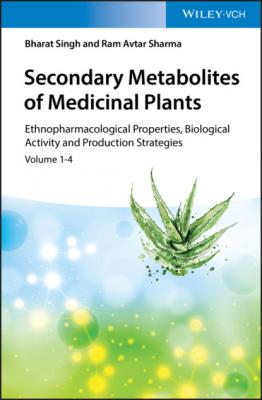Secondary Metabolites of Medicinal Plants. Bharat Singh
Читать онлайн.| Название | Secondary Metabolites of Medicinal Plants |
|---|---|
| Автор произведения | Bharat Singh |
| Жанр | Химия |
| Серия | |
| Издательство | Химия |
| Год выпуска | 0 |
| isbn | 9783527825592 |
Other chromene compounds such as encecalin, 6-vinyl-7-methoxy-2,2-dimethylchromene, dihydroencecalin, dihydrodemethoxyencecalin, demethoxyencecalin, demethylencecalin and 2-(1′-oxo-2′-methylpropyl)-2-methyl-6,7-dimethoxychromene, 2,2-dimethylchromene-7-O-β-glucopyranoside, 6-acetyl-2,2′-dimethyl-3,4-dihydrochromene, 6-(1-methoxy ethyl)-7-methoxy-2,2-dimethylchromene, 6-(1-hydroxy ethyl)-7-methoxy-2,2-dimethylchromene, 6-(1-ethoxyethyl)-7-methoxy-2,2-dimethylchromene, 6-angeloyloxy-7-methoxy-2,2-dimethylchromene, encecanescin, 2-(2′-methylethyl)-5,6-dimethoxybenzofuran, 14-hydroxy-2Hβ, 3-dihydroeuparine, 6,7,6′,7′-tetramethoxy-2,2,2′,2′-tetramethyl-3′(4′)-dehydro-3′-4S-bichromene, 3-(2′-methyl propyl)-methyl-6,8-dimethoxychrom-4-one and 2-(2′-methylprop-2′-enyl)-2-methyl-6,7-dimethoxychroman-4-one (Pari et al. 1998; Ahmed et al. 1999; González et al. 1991a; Desai et al. 1973; Srivastava et al. 1985; Katsuri et al. 1973), 5,6,7,8,3′,4′,5′-heptamethoxyflavone (Adesogan and Okunade 1979), 6-(1′-hydroxyethyl)-2,2-dimethylchromene, conyzorigun, and 7-hydroxyl-2,2-dimethylchromene were reported from hexane extract of aerial parts of A. conyzoides (Vyas and Mulchandani 1984; Kasali et al. 2002).
Several polyoxygenated flavones such as ageconyflavones A, B, and C, linderoflavone B, eupalestin, nobiletin, 5′-methoxynobiletin, 5,6,7,5′-tetramethoxy-3′,4′-methylenedioxyflavone, sinensetin, 5,6,7,3′,4′,5′-hexamethoxyflavone, 5,6,7,8,3′-pentamethoxy-4′-hydroxyflavone and 5,6,7,8,3′,5′-hexamethoxy-4′-hydroxyflavone (Vyas and Mulchandani 1986), O-methyl apigenin, and scutellarein tetramethyl ether (Phat and Ngoan 2016); other related compounds obtained from the oil include encecalin, 6-vinyl-7-methoxy-2,2-dimethylchromene, dihydroencecalin, dihydrodemethoxyencecalin, demethoxyencecalin, demethylencecalin (Ekundayo et al. 1988), and 2,2-dimethylchromene-7-O-β-glucopyranoside and 2-(1′-oxo-2′-methylpropyl)-2-methyl-6,7-dimethoxychromene (Pari et al. 1998; Ekundayo et al. 1988); and polyhydroxyflavones such as scutellarein-5,6,7,4′-tetrahydroxyflavone, quercetin, quercetin-3-rhamnopyranoside, kaempferol, kaempferol-3-rhamnopyranoside and kaempferol 3,7-diglucopyranoside (Palanniappan et al. 1983; Singh et al. 2013), 2,2-dimethylchromene-7-O-β-glucopyranoside (Ahmed et al. 1999), 6-(1-methoxyethyl)-7-methoxy-2,2-dimethylchromene, 6-(1-hydroxyethyl)-7-methoxy-2,2-dimethylchromene, 6-(1-ethoxyethyl)-7-methoxy-2,2-dimethylchromene, 6-angeloyloxy-7-methoxy-2,2-dimethylchromene, and an inseparable mixture of encecanescins have been isolated from A. conyzoides (González et al. 1991b).
Benzofuran derivatives such as 2-(2′-methylethyl)-5,6-dimethoxybenzofuran and 14-hydroxy-2Hβ,3-dihydroeuparine (Ahmed et al. 1999) as well as chromone derivatives, 3-(2′-methylpropyl)-2-methyl-6,8-dimethoxychrom-4-one and 2-(2′-methylprop-2′-enyl)-2-methyl-6,7-dimethoxychroman-4-one, have also been identified from this plant species (Pari et al. 1998). Besides benzofuran derivatives, the triterpenes such as friedelin, β-sitosterol, stigmasterol, brassicasterol, dihydrobrassicasterol, spinasterol, dihydrospinasterol, lycopsamine, echinatine, (+)-sesamin, aurantiamide acetate, fumaric acid, caffeic acid, phytol and hydrocarbons, (nC27–H56 to nC32–H66) have also been isolated from A. conyzoides (Wiedenfeld and Roder 1991; Riaz et al. 1991).
Ageratum conyzoides is very rich in polyoxygenated flavonoids (González et al. 1991b; Vyas and Mulchandani 1986; González et al. 1984; Quijano 1980a,b; Adesogan and Okunade 1978, 1979; Horie et al. 1993), 3′,4′,5′-oxygenated flavones, 5′-methoxynobiletin, linderoflavone B, 5,6,7,3′,4′,5′-hexamethoxyflavone, 5,6,8,3′,4′,5′-hexamethoxyflavone, eupalestin (González et al. 1991a; Vyas and Mulchandani 1986), scutellarein-5,6,7,4′-tetrahydroxyflavone, quercetin, quercetin-3-rhamnopyranoside, kaempferol, kaempferol-3-rhamnopyranoside, and kaempferol 3,7-diglucopyranoside (Gill et al. 1978; Nair et al. 1977; Yadara and Kumar 1999). The coumarins such as ageratochromene, β-caryophyllene, caffeic acid, caryophyllene epoxide, echinatine, eugenol, fumaric acid, kaempferol-3,7-diglucopyranoside, precocene I, precocene II α-pinene, β-pinene, δ-cadinene, 2-(1′-oxo-2′-methylpropyl)-2-methyl-6,7-dimethoxy-chromene, 2-(2′-methylprop-2′-enyl)-2-methyl-6,7-dimethoxychroman-19-one, -(2′-methylpropyl)-2-methyl-6,8-dimethoxychrom-19-one,2-(2′-methylethyl)-5,6-dimethoxybenzofuran, 5,7,2′,19′-tetrahydroxy-6,3′-di-(3,3-dimethylallyl)-isoflavone, 5-O-α-l-rhamnopyrosyl-(1→19)-α-l-rhamnopyranoside, methyl-6,7-dimethoxy chromene have been reported from A. conyzoides (Singh et al. 2013; Kupriyanova 1997; Adebayo et al. 2010a,b), encecalol and demethoxyencecalol (González et al. 1991b), sesamin (Moazzami et al. 2007), linderoflavone B (Saxena and Shrivastava 1994), 3′-hydroxy-5,6,7,8,4′,5′-hexamethoxyflavone (Herz and Kulanthaivel 1982), 5′-methoxynobiletin (Le-Van and Van Cuong Pham 1979; Herz et al. 1980), and 2-hydroxycinnamic and 2-hydroxydihydrocinnamic acids have been reported from A. conyzoides (Gerothanassis et al. 1998). The lycopsamine, lycopsamine N-oxide, dihydrolycopsamine, dihydrolycopsamine N-oxide, acetyllycopsamine, and acetyllycopsamine N-oxide were isolated from A. conyzoides (Okunade 2002; Bosi et al. 2013).
